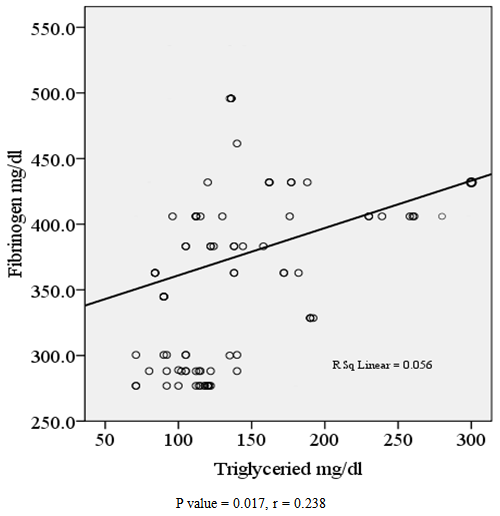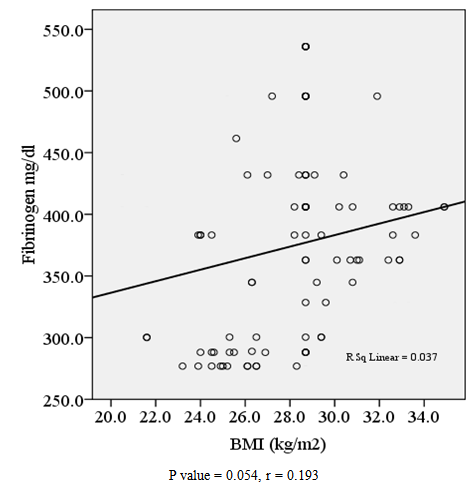-
Paper Information
- Next Paper
- Previous Paper
- Paper Submission
-
Journal Information
- About This Journal
- Editorial Board
- Current Issue
- Archive
- Author Guidelines
- Contact Us
American Journal of Medicine and Medical Sciences
p-ISSN: 2165-901X e-ISSN: 2165-9036
2014; 4(5): 161-165
doi:10.5923/j.ajmms.20140405.04
Measurements of Plasma Fibrinogen Level, Total Cholesterol and Triglyceride Levels in Hypertensive Sudanese Patients
Soha Saif Alden Osman1, Abdalla Eltom Ali1, Abdel Rahim Mahmoud Muddathir2
1Department of clinical chemistry, Faculty of Medical Laboratory Sciences, Alzaiem Alazhari University, Khartoum, Sudan
2Department of Hematology and Blood transfusion, Faculty of Medical Laboratory Sciences, Alzaiem Alazhari University, Khartoum, Sudan
Correspondence to: Abdel Rahim Mahmoud Muddathir, Department of Hematology and Blood transfusion, Faculty of Medical Laboratory Sciences, Alzaiem Alazhari University, Khartoum, Sudan.
| Email: |  |
Copyright © 2014 Scientific & Academic Publishing. All Rights Reserved.
BackgroundHypertension the most common worldwide diseases affecting humans. Fibrinogen is a major independent risk factor for cardiovascular diseases. Total cholesterol and triglyceride are important risk factors for stroke and progression heart diseases in hypertensive patients. The study aimed to measure the plasma fibrinogen, total cholesterol and triglyceride levels in primary hypertensive patients and to find the correlation between fibrinogen, total cholesterol, triglycerides and body mass index in Sudanese hypertension patients. Materials and methods This was descriptive cross sectional study, conducted in Al-Enqaz medical center and Sudan Heart Center in Khartoum state (Sudan) during the period from January to June 2012. One hundred hypertensive patients and forty normal controls were enrolled in this study. Fibrinogen level is assayed by the Clauss method, while cholesterol and triglycerides were measured spectrophotometrically using Biosystms BTS 310. Results Plasma fibrinogen, total cholesterol and triglyceride levels were significantly increased in hypertensive patients than in control group. The result showed a significant correlation between fibrinogen concentration and total cholesterol, triglyceride and body mass index in hypertensive patients. Discussion and Conclusion The study concluded that plasma fibrinogen; total cholesterol and triglyceride levels were significantly increased in hypertensive patients. There was correlation between fibrinogen concentration with total cholesterol, triglyceride and body mass index in hypertensive patients, so measurement of fibrinogen level with total cholesterol and triglyceride levels may be benefit to avoid the complication of hypertension.
Keywords: FIB, Cholesterol, TG, Hypertension, Thrombosis, CHD
Cite this paper: Soha Saif Alden Osman, Abdalla Eltom Ali, Abdel Rahim Mahmoud Muddathir, Measurements of Plasma Fibrinogen Level, Total Cholesterol and Triglyceride Levels in Hypertensive Sudanese Patients, American Journal of Medicine and Medical Sciences, Vol. 4 No. 5, 2014, pp. 161-165. doi: 10.5923/j.ajmms.20140405.04.
Article Outline
1. Introduction
- Hypertension occurs when pressure inside the blood vessels is too high. Over time, however, the strain hypertension places on the heart and blood vessels can increase the risk of heart disease, stroke, and kidney damage [1, 2]. In Sudan, the prevalence of hypertension in an urban area increased from 7.5% in 1985 to 18.2% in 2002 [3]. Most of the time, no cause of high blood pressure is found and this is called essential hypertension. High blood pressure that is caused by another medical condition or medication is called secondary hypertension. Secondary hypertension may be due to Chronic disorders of the adrenal gland (pheochromocytoma or Cushing syndrome), pregnancy, medications such as birth control pills, diet pills, some cold medications, and migraine medications, narrowed artery that supplies blood to the kidney (renal artery stenosis) and hyperparathyroidism [4]. Fibrinogen is an important component of the coagulation as well as a major determinant of blood viscosity, and it is also involved in haemostasis and thrombosis pathway [5, 6]. It has been identified as a major independent risk factor for cardiovascular disease [7]. Moreover, the results of the Leigh study, in which hypertensive patients with plasma fibrinogen above 3.5 g/L had a 12-fold greater coronary risk than those with fibrinogen below 2.9 g/L, suggest that fibrinogen levels may affect prognosis in hypertension [8]. Cholesterol is a waxy fat-like substance produced by the body and found in certain foods. High cholesterol may contribute to high blood pressure levels and is a risk factor for heart disease [9]. High cholesterol levels and hypertension can increase the risk of developing heart disease. Both can disrupt blood flow to the heart and other vital organs [10]. Triglycerides play an important role in metabolism as energy sources and transporters of dietary fat. In the human body, high levels of triglycerides in the blood stream have been linked to atherosclerosis and, by extension, the risk of heart disease and stroke [11]. High triglyceride levels were associated with a collection of disorders known as ‘metabolic syndrome’. A person with metabolic syndrome has an increased risk of developing diabetes, stroke or heart disease. A person is classed as having metabolic syndrome when they have any three of the following factors: Central (abdominal) obesity – excess fat in and around the stomach (abdomen), high blood pressure (hypertension), higher than normal blood glucose levels, low HDL (high density lipoprotein) cholesterol and high blood triglycerides [12].
2. Materials and Methods
2.1. Study Population
- This was descriptive cross sectional study, conducted in Al-Enqaz medical center and Sudan Heart Center in Khartoum state during the period of January to June 2012. The study aimed to measure the plasma fibrinogen level, total cholesterol and triglyceride levels among 100 known diagnosed hypertensive Sudanese patients treated with anti hypertensive drugs, their age ranged (35 – 65) years and 40 non-hypertensive individuals as control group. Patients with diabetes mellitus, cardiovascular diseases, liver disease, kidney disease, in addition to the patients under anticoagulant therapy, also whom were smoking, pregnancy, having disorders associated with inflammation and other diseases such as DVT or treatments that may affect coagulation system were excluded. Secondary causes of hypertension and hypertensive patients with target organ damage have been excluded also. A signed informed consent was obtained from each participant and the Data was obtained by direct interviewing using structured questionnaire.
2.2. Specimen Collection and Preparation
- A total of 6.5 ml of venous blood sample was collected from each participant, 3ml of venous blood samples were collected in lithium heparin container for measurement of cholesterol and triglyceride, all the donors were instructed to be fasting overnight (10-12 hours) before collection of the sample, Plasma was separated by centrifugation into a plain container and stored at -20℃ until assayed. For fibrinogen, the remaining 3.5 ml of venous blood samples were collected in 3.8% sodium citrate container of 9 part blood to 1 part anticoagulant. The blood is thoroughly mixed with the anticoagulant. The samples were centrifuged at 2000g for 15 minutes to obtain platelet-poor plasma (PPP), then Plasma was separated from cells into plain container. PPP will be stored at refrigerator at (2-8℃) and tested within 4 hours from preparation.
2.3. Method
- Free and esterifies cholesterol and triglyceride in the sample originates by means of the coupled reactions, a colored complex that can be measured by spectrophotometer using automated analyzer (Biosystems BTS 310). Plasma fibrinogen level was assayed by the Clauss technique using automated blood coagulation analyzer (Sysmex CA-500 series).
2.4. Data Analysis
- The SPSS-version 16 software was used for statistical analysis. Independent sample T-Test was used to calculate P value and level of statistical significance was set at p ≤ 0.05.
3. Results
- The mean of plasma fibrinogen level was significantly higher in hypertensive patients (373.815mg/dl) than in control group (334.340mg/dl), with p value = 0.005, while the mean of total cholesterol level was significantly higher in hypertensive patients (177.81mg/dl) than in control group (158.82mg/dl), with p value= 0.004,the mean of triglyceride level in patient group was significantly higher (135.39mg/dl) than in control group (107.75mg/dl), with p value = 0.002 and the mean of BMI was significantly higher in hypertensive patients (28.004 k/m2) than in control group (26.033 k/m2), with p value = 0.001 (Table 1). Scatter gram showed a significant correlation between fibrinogen and total cholesterol levels (p value = 0.000), figure 1. Also a significant correlation between fibrinogen and triglyceride levels (p value = 0.017) figure 2. Scatter gram showed a significant correlation between fibrinogen level and BMI (p value = 0.05), (Figure 3).
|
 | Figure 1. Scatter shows the correlation between fibrinogen and T. cholesterol levels in hypertensive patients |
 | Figure 2. Scatter shows the correlation of fibrinogen with triglyceride in hypertensive patients |
 | Figure 3. Scatter shows the correlation of fibrinogen with body mass index in hypertensive patients |
4. Discussion
- This study demonstrated that, the plasma fibrinogen, total cholesterol and triglyceride levels were significantly increased in hypertension patients when compared with control group. This result was in agreement with Tabak et al [13], Fogari R et al [14], Joseph Osagie et al [15] and Sarkar D [16]. The study also demonstrated a significant correlation between plasma fibrinogen level with total cholesterol and triglyceride levels in hypertensive patients and this result was in agreement with Fogari R et al [14]. Similarly there was a significant correlation between plasma fibrinogen level and BMI and this result was in agreement with Anoop Shankar et al [17], Krobot K et al [18] and Carroll S et al [19]. The study disagreed with Sechi et al [20] in which they did not observed differences in plasma fibrinogen level between hypertensive patients and control group.
5. Conclusions
- The impact of plasma fibrinogen levels on hypertensive patients was compared with the major risk factors, such as increase body mass index and increase in lipid profile. The study concluded that plasma fibrinogen, total cholesterol and triglyceride levels were significantly increased in hypertension. Moreover, there were significant correlation between plasma fibrinogen level and total cholesterol, triglyceride levels and body mass index, so measurement of fibrinogen level with total cholesterol and triglyceride levels may be benefit to avoid the complication of hypertension.
ACKNOWLEDGEMENTS
- Thanks to the medical staff of Al-Enqaz medical center and Sudan Heart Center in Khartoum state (Sudan) for helping me in samples collection and processing with Special thanks to teachers and colleagues in Faculty of Medical Laboratory Science of Alaeim Alazhari University, for their encouragement and support.
 Abstract
Abstract Reference
Reference Full-Text PDF
Full-Text PDF Full-text HTML
Full-text HTML